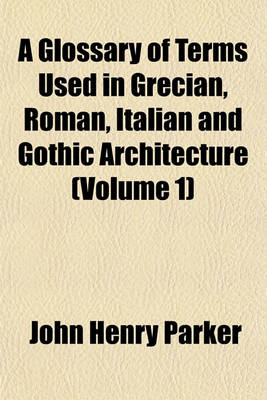Cambridge Library Collection - Art and Architecture
3 primary works • 4 total works
Volume 1
A Glossary of Terms Used in Grecian, Roman, Italian and Gothic Architecture (Volume 1)
by John Henry Parker
Published 9 January 2010
The Oxford bookseller and publisher John Henry Parker (1806-84), a supporter of the Tractarian movement and a friend of Cardinal Newman, was also a historian of architecture, and first published this glossary in 1836. Reissued here is the enlarged third edition of 1840. The work is ordered alphabetically, and illustrated with 700 woodcuts by various artists. As stated in the first edition's preface, the book 'lays no claim to originality, its sole object being utility'. By 1837, 'the rapid sale of the first edition of this work clearly shews that something of the kind was required'. The third edition was followed in 1841 by a companion volume which contained 400 further examples and a chronological table: the two books offered a useful guide for those travellers and others who were taking a keen interest in the built environment. The first volume contains explanations of terms from 'abacus' to 'zotheca' and 105 plates with notes.
Volume 2
Some Account of Domestic Architecture in England: Volume 2
by John Henry Parker
Published 17 April 2014
The Oxford bookseller and publisher John Henry Parker (1806-84), a supporter of the Tractarian movement and a friend of Cardinal Newman, was also a historian of architecture, whose two-volume Glossary of Terms Used in Grecian, Roman, Italian, and Gothic Architecture is also reissued in this series. In 1851, he published a volume on English domestic architecture from the Norman Conquest to 1300 by the antiquary Thomas Hudson Turner (1815-52), and on Turner's death he completed the second volume, on the fourteenth century, himself. Both volumes are highly illustrated with line drawings and plans. Volume 2 follows a similar plan, describing the rooms (such as halls, kitchens and chambers) common to domestic buildings, of whatever size, in the fourteenth century, and discussing their individual features and construction. The coverage of surviving buildings is organised by county, and there is a section on comparable buildings in France.
Volume 2
The Oxford bookseller and publisher John Henry Parker (1806-84), a supporter of the Tractarian movement and a friend of Cardinal Newman, was also a historian of architecture, and first published this glossary in 1836. Reissued here is the enlarged third edition of 1840. The work is ordered alphabetically, and illustrated with 700 woodcuts by various artists. As stated in the first edition's preface, the book 'lays no claim to originality, its sole object being utility'. By 1837, 'the rapid sale of the first edition of this work clearly shews that something of the kind was required'. The third edition was followed in 1841 by a companion volume: the two books offered a useful guide for those travellers and others who were taking a keen interest in the built environment. The companion volume contains further line drawings and plates, an index to the plates in both volumes, and a chronology of the architectural developments and individual buildings being discussed.
Some Account of Domestic Architecture in England 2 Volume Set
by Thomas Hudson Turner and John Henry Parker
Published 17 April 2014
The Oxford bookseller and publisher John Henry Parker (1806-84), a supporter of the Tractarian movement and a friend of Cardinal Newman, was also a historian of architecture, whose two-volume Glossary of Terms Used in Grecian, Roman, Italian, and Gothic Architecture is also reissued in this series. In 1851, he published a volume on English domestic architecture from the Norman Conquest to 1300 by the antiquary Thomas Hudson Turner (1815-52), and on Turner's death he completed the second volume, on the fourteenth century, himself. Both volumes are highly illustrated with line drawings and plans. Volume 1, after an introductory chapter about pre-Conquest buildings, discusses architectural plans, features, building materials and techniques of the twelfth and thirteenth centuries. Volume 2 follows a similar plan, describing elements, such as halls and chambers, common to domestic buildings of the fourteenth century, and discussing their individual features.

